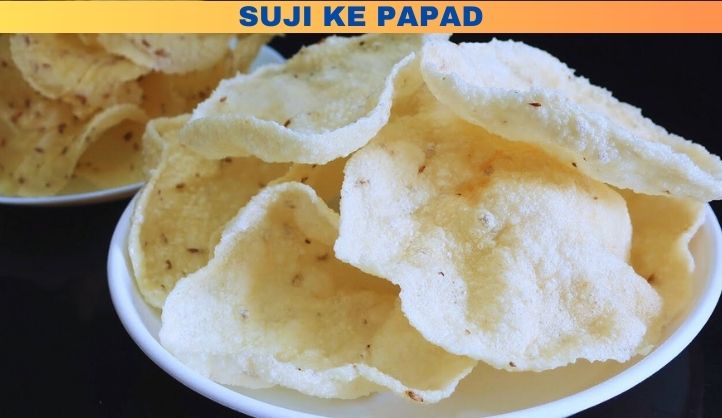Suji ke papad, a traditional delicacy of Uttarakhand, holds a special place in the hearts and homes of the people of this beautiful region. Made from suji (semolina), these thin, crispy papads are a culinary delight and a symbol of cultural heritage and local craftsmanship.
The Art of Making Suji Ke Papad
Crafting suji ke papad is a meticulous process that requires skill, patience, and attention to detail. First, smooth dough is prepared by mixing suji with water and spices like salt, cumin seeds, and sometimes, a pinch of asafoetida. The dough is then rolled out into thin, circular shapes and dried under the sun until it becomes crisp and golden brown.
Cultural Significance
This is more than just a snack; it is deeply intertwined with the cultural fabric of Uttarakhand. Traditionally, women in households across the region come together to make these papads during the summer months when the sun is at its peak. This communal activity strengthens bonds within families and preserves age-old culinary traditions passed down through generations.
Culinary Diversity
While the basic recipe for suji ke papad remains consistent, there are variations in taste and texture across different households and regions of Uttarakhand. Some families prefer to add additional spices or herbs to enhance the flavor, while others might experiment with different shapes and sizes. Regardless of these variations, the essence of suji ke papad remains the same – a crispy, savory treat enjoyed by all.
Suji Ke Papad in Modern Times
In today’s fast-paced world, the art of making suji ke papad faces challenges from modernization and changing lifestyles. However, efforts are being made to preserve this culinary tradition and promote it beyond the borders of Uttarakhand. With the rise of social media and online platforms, it is gaining recognition as a unique regional delicacy, attracting food enthusiasts and tourists alike.
Savoring Suji Ke Papad- Where to Find Them
For those eager to experience the authentic taste of suji ke papad, Uttarakhand offers numerous opportunities. Visitors can explore local markets in towns and villages across the state, where these papads are often sold alongside other regional specialties. Additionally, many homestays and eco-resorts in Uttarakhand include this on their menus, allowing guests to enjoy this traditional treat amidst the breathtaking beauty of the Himalayas.
Embracing Sustainability and Community
Beyond its culinary appeal, the production of suji ke papad also reflects principles of sustainability and community involvement. The reliance on natural sunlight for drying and the use of locally sourced ingredients minimize environmental impact, while the communal process of making papads strengthens social bonds and fosters a sense of shared heritage. By supporting local artisans and producers, visitors can contribute to the preservation of this time-honored tradition while indulging in its delicious flavors.
Spreading the Joy of Suji Ke Papad
As awareness of suji ke papad grows, so does its potential to transcend geographical boundaries and cultural barriers. Food enthusiasts and entrepreneurs interested in exploring the diverse culinary landscape of India may find inspiration in the simplicity and authenticity of this regional delicacy. By incorporating it into their menus or product offerings, they can introduce a wider audience to the unique flavors and cultural heritage of Uttarakhand, fostering appreciation and understanding across communities.]
Other Famous Dishes of Uttarakhand
Kafuli
Kafuli is a traditional vegetarian dish native to Uttarakhand, particularly popular in the Kumaon region. It is made from spinach (or other leafy greens), often combined with fenugreek leaves, and cooked in a flavorful gravy of buttermilk and spices. Kafuli is nutritious, delicious, and a staple in many Uttarakhandi households.
Bhang ki Chutney
Bhang ki chutney is a unique chutney made from hemp seeds, a common ingredient in Uttarakhandi cuisine. The seeds are ground with garlic, green chilies, and other spices to create a flavorful and aromatic condiment. Bhang ki chutney adds a spicy kick to meals and is often served with rice, roti, or snacks like pakoras.
Aloo ke Gutke
Aloo ke gutke is a popular potato dish from Uttarakhand, especially prevalent in the Garhwal region. Cubes of potatoes are fried until crispy and then tossed with a medley of spices such as cumin seeds, coriander powder, turmeric, and red chili powder. Aloo ke gutke is typically served as a side dish with roti or rice.
Phaanu
Phaanu is a nutritious lentil stew enjoyed in Uttarakhand, particularly during winter. It is made from a variety of lentils (usually a mix of urad dal and arhar dal) soaked, ground, and slow-cooked with spices like cumin, asafoetida, and ghee. Phaanu is hearty, comforting, and often served with steamed rice.
Singal
Singal is a popular snack or breakfast dish in Uttarakhand, especially in the Garhwal region. It consists of deep-fried dough balls made from a mixture of wheat flour, jaggery, and fennel seeds. Singal is crispy on the outside and soft on the inside, making it a delightful treat enjoyed with tea or as a quick bite on the go.
A Taste of Tradition
In essence, suji ke papad encapsulates the essence of Uttarakhand – a harmonious blend of tradition, innovation, and natural beauty. Whether enjoyed as a snack on a lazy afternoon or shared during festive gatherings, these crispy delights carry with them the stories of generations past and the promise of a vibrant culinary future. As we embark on our culinary adventures, let us remember to savor not just the flavors but also the rich tapestry of culture and heritage woven into each bite of suji ke papad.
Conclusion
Suji ke papad is not just a snack; it is a symbol of Uttarakhand’s rich cultural heritage and culinary legacy. From its humble origins in household kitchens to its growing popularity in the culinary world, suji ke papad continues to captivate taste buds and hearts alike. As we savor each crispy bite, let us also cherish the traditions and stories woven into every strand of this beloved delicacy.
FAQs About Suji Ke Papad
1. What is the main ingredient in suji ke papad?
The main ingredient in suji ke papad is suji, also known as semolina. It is mixed with water and spices to form a dough, which is then rolled out and dried to make the papads.
2. How are suji ke papads traditionally made?
Traditionally, suji ke papads are made by mixing suji with water and spices to form a dough. The dough is then rolled out into thin, circular shapes and left to dry under the sun until it becomes crisp.
3. Are there variations in the recipe for suji ke papad?
Yes, there are variations in the recipe for suji ke papad across different households and regions of Uttarakhand. Some families may add additional spices or herbs to enhance the flavor, while others may experiment with different shapes and sizes.
4. When is the best time to enjoy suji ke papad?
Suji ke papads are traditionally made during the summer months when the sun is at its peak. This is because they require sunlight for drying. However, they can be enjoyed year-round as a savory snack or accompaniment to meals.
5. Where can I find suji ke papads in Uttarakhand?
Suji ke papads can be found in local markets across Uttarakhand, as well as in homestays and eco-resorts that offer regional cuisine. They are also sometimes sold by local artisans and producers in towns and villages throughout the state.
6. How long do suji ke papads last?
Properly dried and stored suji ke papads can last for several months to a year. It is important to store them in a cool, dry place away from moisture to prevent them from becoming soggy or moldy.






